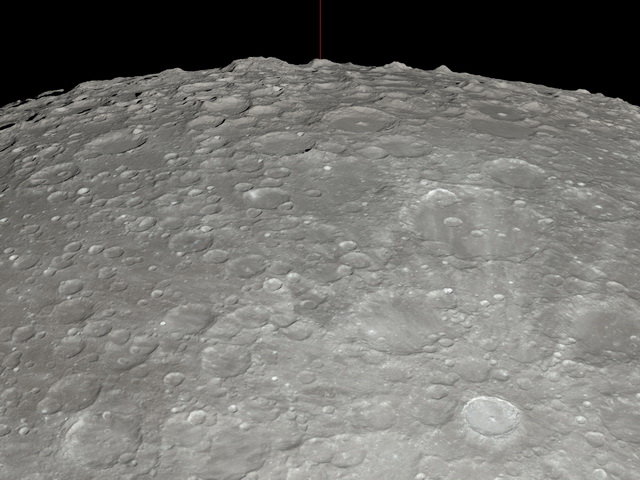Rendered LUNEX Examples - With POV-Ray v3.7 Source Code
Written and Rendered by Jay Tanner |
The following examples were rendered by the LUNEX (POV-Ray Lunar Explorer) program. The LUNEX source code used to generate the images is displayed below each rendering in plain-text and can be copied and pasted into the LUNEX program SCENE DEFINITION PANEL, replacing the default settings, to produce a similar rendering.
These examples could possibly take a long time to render, depending on the scene definition settings, the dimensions of your rendered image and your system speed and RAM/CPU/GPU architecture. A fast multi-core CPU and a high-end graphics card and lots of RAM is recommended, since 3D photo-realistic ray-tracing is extremely resource intensive.
Although some of these example renderings are rather large, the images can be rendered at any smaller user-defined scale as needed. They were rendered large on purpose (most are 2560x1920) in order to demonstrate the potential of the LUNEX program.
|
-

This rendering shows the location of Tranquility Base, where American
astronaut Neil Armstrong set the first human footprint on the moon.
The vertical and horizontal red lines are the lunar prime meridian and
equator respectively
on a 5×5-degree coordinate grid.
The pointer shows the location of Tranquility Base at selenographic
latitude +0.67409° (N) and longitude +23.47298° (E).
Double-Click Within Text Area to Select ALL Code
-

This view is centered on the crater Korolev on the far side of the moon.
It is the bottom part of the 'figure-8' in the image.
Double-Click Within Text Area to Select ALL Code
-

This is a color-coded altimetry (elevation) view of the Aiken Basin region in the south polar
region of the far side of the moon. It is the oldest and largest known impact crater at about
1550 miles wide (2500 km) and about 3.9 to 5.1 miles (6.2 to 8.2 km) deep in certain areas.
 This is the elevation color-legend for the altimetric image above.
This is the elevation color-legend for the altimetric image above.
Double-Click Within Text Area to Select ALL Code
-

This is a view from above the bright crater Aristarchus looking to the northeast towards
Sinus Iridum and Mare Imbrium and the crater Plato near the upper horizon.
Double-Click Within Text Area to Select ALL Code
-

This is an evening crescent moon at phase 315 degrees.
Double-Click Within Text Area to Select ALL Code
-

This is a view of the Sea of Moscow and craters Mendeleev and Gregarin
from an orbital distance of about 1/10 mean lunar distance.
Double-Click Within Text Area to Select ALL Code
-

This is a rendering of the hidden far-side of the moon. We are on
the other side of the moon at mean distance looking back,
while from Earth, it is a New Moon.
Double-Click Within Text Area to Select ALL Code
-

This is a view of Mare Oriental, the bright crater Byrgius, the dark basin Grimaldi, which is just
visible from Earth on the limb of the western lunar hemisphere, with part of Oceanus Procellarum.
Double-Click Within Text Area to Select ALL Code
-

This is a view centered on the Mare Crisium region from about 1/10 mean lunar distance.
This perspective is only possible from space.
Double-Click Within Text Area to Select ALL Code
-

This view is centered over Hertzsprung crater in the western hemisphere of
the lunar far-side. It is a large crater some 591 km (367 mi) in diameter.
Double-Click Within Text Area to Select ALL Code
-

This is a gravimetric image of the moon. The dark blue and purple areas are where gravity is
lowest
and the yellow, orange and red areas are where the gravity is highest.
There are mass concentrations buried within the moon which are revealed
by the redish areas where the gravitational field is greatest.
Double-Click Within Text Area to Select ALL Code
-

This is a space view of the crater Tycho and the mountains along the southern
limb of the moon just past full phase from a distance of about 24,000
miles with 5x zoom.
Double-Click Within Text Area to Select ALL Code
-

This is a view of the Mare Smythii region without the lunar surface color and with only the 3D
relief and a 5x5-degree coordinate overlay grid, as if the moon was made of white plaster with
a 5×5-degree coordinate grid painted on it.
Double-Click Within Text Area to Select ALL Code
|
|